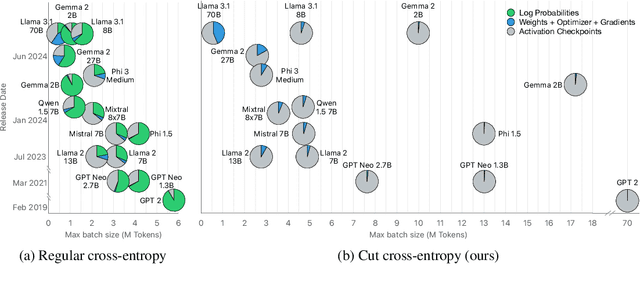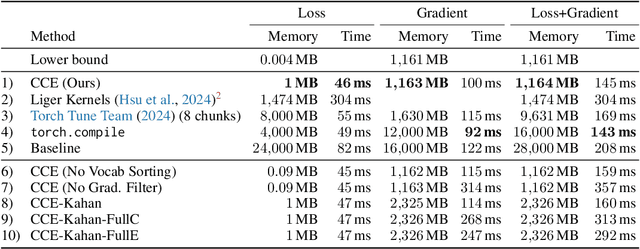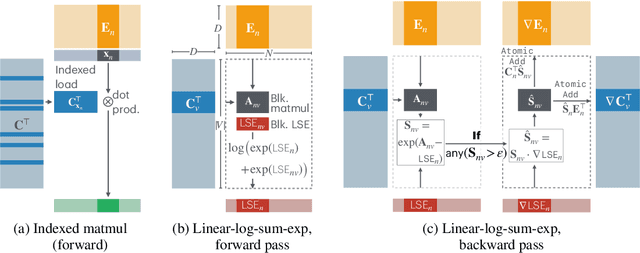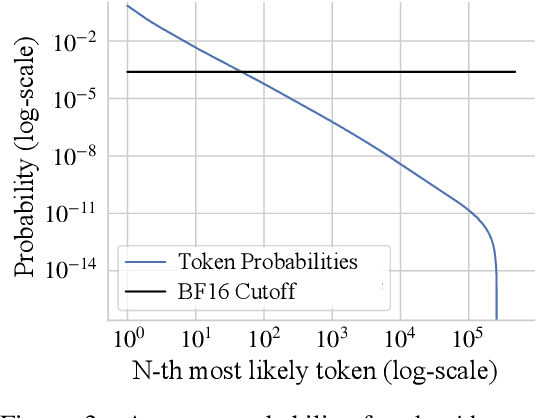Philipp Krähenbühl
Spherical Leech Quantization for Visual Tokenization and Generation
Dec 16, 2025Abstract:Non-parametric quantization has received much attention due to its efficiency on parameters and scalability to a large codebook. In this paper, we present a unified formulation of different non-parametric quantization methods through the lens of lattice coding. The geometry of lattice codes explains the necessity of auxiliary loss terms when training auto-encoders with certain existing lookup-free quantization variants such as BSQ. As a step forward, we explore a few possible candidates, including random lattices, generalized Fibonacci lattices, and densest sphere packing lattices. Among all, we find the Leech lattice-based quantization method, which is dubbed as Spherical Leech Quantization ($Λ_{24}$-SQ), leads to both a simplified training recipe and an improved reconstruction-compression tradeoff thanks to its high symmetry and even distribution on the hypersphere. In image tokenization and compression tasks, this quantization approach achieves better reconstruction quality across all metrics than BSQ, the best prior art, while consuming slightly fewer bits. The improvement also extends to state-of-the-art auto-regressive image generation frameworks.
Interactive Post-Training for Vision-Language-Action Models
May 22, 2025Abstract:We introduce RIPT-VLA, a simple and scalable reinforcement-learning-based interactive post-training paradigm that fine-tunes pretrained Vision-Language-Action (VLA) models using only sparse binary success rewards. Existing VLA training pipelines rely heavily on offline expert demonstration data and supervised imitation, limiting their ability to adapt to new tasks and environments under low-data regimes. RIPT-VLA addresses this by enabling interactive post-training with a stable policy optimization algorithm based on dynamic rollout sampling and leave-one-out advantage estimation. RIPT-VLA has the following characteristics. First, it applies to various VLA models, resulting in an improvement on the lightweight QueST model by 21.2%, and the 7B OpenVLA-OFT model to an unprecedented 97.5% success rate. Second, it is computationally efficient and data-efficient: with only one demonstration, RIPT-VLA enables an unworkable SFT model (4%) to succeed with a 97% success rate within 15 iterations. Furthermore, we demonstrate that the policy learned by RIPT-VLA generalizes across different tasks and scenarios and is robust to the initial state context. These results highlight RIPT-VLA as a practical and effective paradigm for post-training VLA models through minimal supervision.
PerceptionLM: Open-Access Data and Models for Detailed Visual Understanding
Apr 17, 2025



Abstract:Vision-language models are integral to computer vision research, yet many high-performing models remain closed-source, obscuring their data, design and training recipe. The research community has responded by using distillation from black-box models to label training data, achieving strong benchmark results, at the cost of measurable scientific progress. However, without knowing the details of the teacher model and its data sources, scientific progress remains difficult to measure. In this paper, we study building a Perception Language Model (PLM) in a fully open and reproducible framework for transparent research in image and video understanding. We analyze standard training pipelines without distillation from proprietary models and explore large-scale synthetic data to identify critical data gaps, particularly in detailed video understanding. To bridge these gaps, we release 2.8M human-labeled instances of fine-grained video question-answer pairs and spatio-temporally grounded video captions. Additionally, we introduce PLM-VideoBench, a suite for evaluating challenging video understanding tasks focusing on the ability to reason about "what", "where", "when", and "how" of a video. We make our work fully reproducible by providing data, training recipes, code & models.
QLIP: Text-Aligned Visual Tokenization Unifies Auto-Regressive Multimodal Understanding and Generation
Feb 07, 2025Abstract:We introduce Quantized Language-Image Pretraining (QLIP), a visual tokenization method that combines state-of-the-art reconstruction quality with state-of-the-art zero-shot image understanding. QLIP trains a binary-spherical-quantization-based autoencoder with reconstruction and language-image alignment objectives. We are the first to show that the two objectives do not need to be at odds. We balance the two loss terms dynamically during training and show that a two-stage training pipeline effectively mixes the large-batch requirements of image-language pre-training with the memory bottleneck imposed by the reconstruction objective. We validate the effectiveness of QLIP for multimodal understanding and text-conditioned image generation with a single model. Specifically, QLIP serves as a drop-in replacement for the visual encoder for LLaVA and the image tokenizer for LlamaGen with comparable or even better performance. Finally, we demonstrate that QLIP enables a unified mixed-modality auto-regressive model for understanding and generation.
Robust Autonomy Emerges from Self-Play
Feb 05, 2025Abstract:Self-play has powered breakthroughs in two-player and multi-player games. Here we show that self-play is a surprisingly effective strategy in another domain. We show that robust and naturalistic driving emerges entirely from self-play in simulation at unprecedented scale -- 1.6~billion~km of driving. This is enabled by Gigaflow, a batched simulator that can synthesize and train on 42 years of subjective driving experience per hour on a single 8-GPU node. The resulting policy achieves state-of-the-art performance on three independent autonomous driving benchmarks. The policy outperforms the prior state of the art when tested on recorded real-world scenarios, amidst human drivers, without ever seeing human data during training. The policy is realistic when assessed against human references and achieves unprecedented robustness, averaging 17.5 years of continuous driving between incidents in simulation.
Reinforcement Learning for Long-Horizon Interactive LLM Agents
Feb 04, 2025Abstract:Interactive digital agents (IDAs) leverage APIs of stateful digital environments to perform tasks in response to user requests. While IDAs powered by instruction-tuned large language models (LLMs) can react to feedback from interface invocations in multi-step exchanges, they have not been trained in their respective digital environments. Prior methods accomplish less than half of tasks in sophisticated benchmarks such as AppWorld. We present a reinforcement learning (RL) approach that trains IDAs directly in their target environments. We formalize this training as a partially observable Markov decision process and derive LOOP, a data- and memory-efficient variant of proximal policy optimization. LOOP uses no value network and maintains exactly one copy of the underlying LLM in memory, making its implementation straightforward and as memory-efficient as fine-tuning a single LLM. A 32-billion-parameter agent trained with LOOP in the AppWorld environment outperforms the much larger OpenAI o1 agent by 9 percentage points (15% relative). To our knowledge, this is the first reported application of RL to IDAs that interact with a stateful, multi-domain, multi-app environment via direct API calls. Our analysis sheds light on the effectiveness of RL in this area, showing that the agent learns to consult the API documentation, avoid unwarranted assumptions, minimize confabulation, and recover from setbacks.
Cut Your Losses in Large-Vocabulary Language Models
Nov 13, 2024



Abstract:As language models grow ever larger, so do their vocabularies. This has shifted the memory footprint of LLMs during training disproportionately to one single layer: the cross-entropy in the loss computation. Cross-entropy builds up a logit matrix with entries for each pair of input tokens and vocabulary items and, for small models, consumes an order of magnitude more memory than the rest of the LLM combined. We propose Cut Cross-Entropy (CCE), a method that computes the cross-entropy loss without materializing the logits for all tokens into global memory. Rather, CCE only computes the logit for the correct token and evaluates the log-sum-exp over all logits on the fly. We implement a custom kernel that performs the matrix multiplications and the log-sum-exp reduction over the vocabulary in flash memory, making global memory consumption for the cross-entropy computation negligible. This has a dramatic effect. Taking the Gemma 2 (2B) model as an example, CCE reduces the memory footprint of the loss computation from 24 GB to 1 MB, and the total training-time memory consumption of the classifier head from 28 GB to 1 GB. To improve the throughput of CCE, we leverage the inherent sparsity of softmax and propose to skip elements of the gradient computation that have a negligible (i.e., below numerical precision) contribution to the gradient. Experiments demonstrate that the dramatic reduction in memory consumption is accomplished without sacrificing training speed or convergence.
Promptable Closed-loop Traffic Simulation
Sep 09, 2024


Abstract:Simulation stands as a cornerstone for safe and efficient autonomous driving development. At its core a simulation system ought to produce realistic, reactive, and controllable traffic patterns. In this paper, we propose ProSim, a multimodal promptable closed-loop traffic simulation framework. ProSim allows the user to give a complex set of numerical, categorical or textual prompts to instruct each agent's behavior and intention. ProSim then rolls out a traffic scenario in a closed-loop manner, modeling each agent's interaction with other traffic participants. Our experiments show that ProSim achieves high prompt controllability given different user prompts, while reaching competitive performance on the Waymo Sim Agents Challenge when no prompt is given. To support research on promptable traffic simulation, we create ProSim-Instruct-520k, a multimodal prompt-scenario paired driving dataset with over 10M text prompts for over 520k real-world driving scenarios. We will release code of ProSim as well as data and labeling tools of ProSim-Instruct-520k at https://ariostgx.github.io/ProSim.
Image and Video Tokenization with Binary Spherical Quantization
Jun 11, 2024Abstract:We propose a new transformer-based image and video tokenizer with Binary Spherical Quantization (BSQ). BSQ projects the high-dimensional visual embedding to a lower-dimensional hypersphere and then applies binary quantization. BSQ is (1) parameter-efficient without an explicit codebook, (2) scalable to arbitrary token dimensions, and (3) compact: compressing visual data by up to 100$\times$ with minimal distortion. Our tokenizer uses a transformer encoder and decoder with simple block-wise causal masking to support variable-length videos as input. The resulting BSQ-ViT achieves state-of-the-art visual reconstruction quality on image and video reconstruction benchmarks with 2.4$\times$ throughput compared to the best prior methods. Furthermore, by learning an autoregressive prior for adaptive arithmetic coding, BSQ-ViT achieves comparable results on video compression with state-of-the-art video compression standards. BSQ-ViT also enables masked language models to achieve competitive image synthesis quality to GAN- and diffusion-based methods.
Language-Image Models with 3D Understanding
May 06, 2024Abstract:Multi-modal large language models (MLLMs) have shown incredible capabilities in a variety of 2D vision and language tasks. We extend MLLMs' perceptual capabilities to ground and reason about images in 3-dimensional space. To that end, we first develop a large-scale pre-training dataset for 2D and 3D called LV3D by combining multiple existing 2D and 3D recognition datasets under a common task formulation: as multi-turn question-answering. Next, we introduce a new MLLM named Cube-LLM and pre-train it on LV3D. We show that pure data scaling makes a strong 3D perception capability without 3D specific architectural design or training objective. Cube-LLM exhibits intriguing properties similar to LLMs: (1) Cube-LLM can apply chain-of-thought prompting to improve 3D understanding from 2D context information. (2) Cube-LLM can follow complex and diverse instructions and adapt to versatile input and output formats. (3) Cube-LLM can be visually prompted such as 2D box or a set of candidate 3D boxes from specialists. Our experiments on outdoor benchmarks demonstrate that Cube-LLM significantly outperforms existing baselines by 21.3 points of AP-BEV on the Talk2Car dataset for 3D grounded reasoning and 17.7 points on the DriveLM dataset for complex reasoning about driving scenarios, respectively. Cube-LLM also shows competitive results in general MLLM benchmarks such as refCOCO for 2D grounding with (87.0) average score, as well as visual question answering benchmarks such as VQAv2, GQA, SQA, POPE, etc. for complex reasoning. Our project is available at https://janghyuncho.github.io/Cube-LLM.
 Add to Chrome
Add to Chrome Add to Firefox
Add to Firefox Add to Edge
Add to Edge